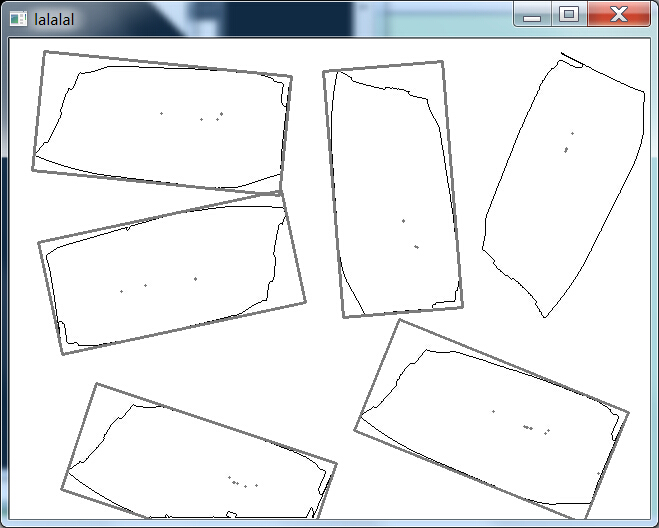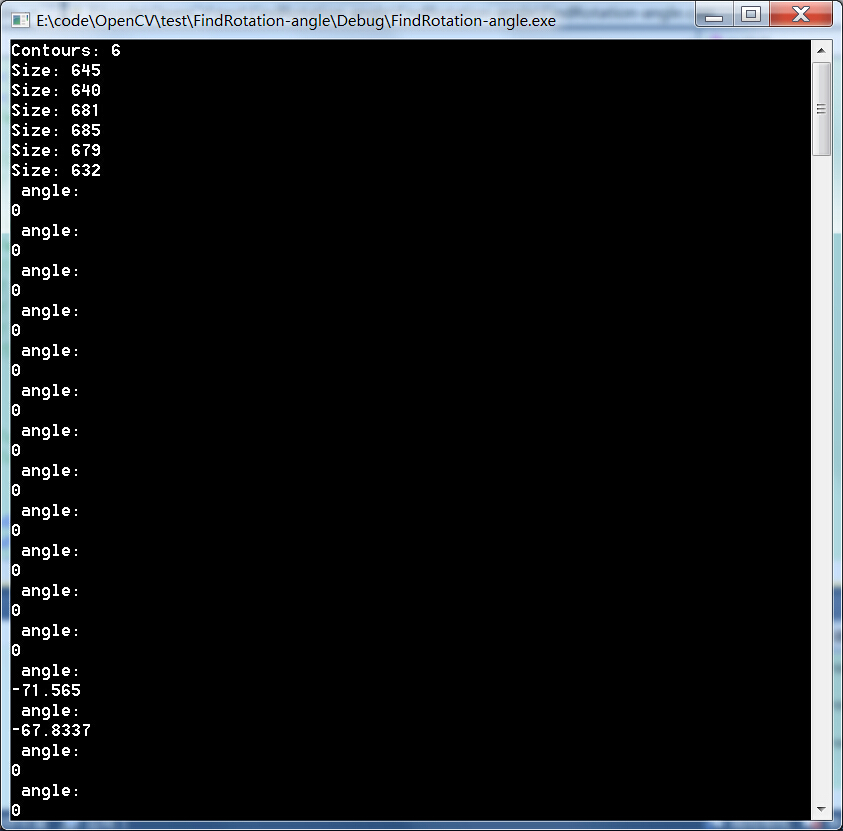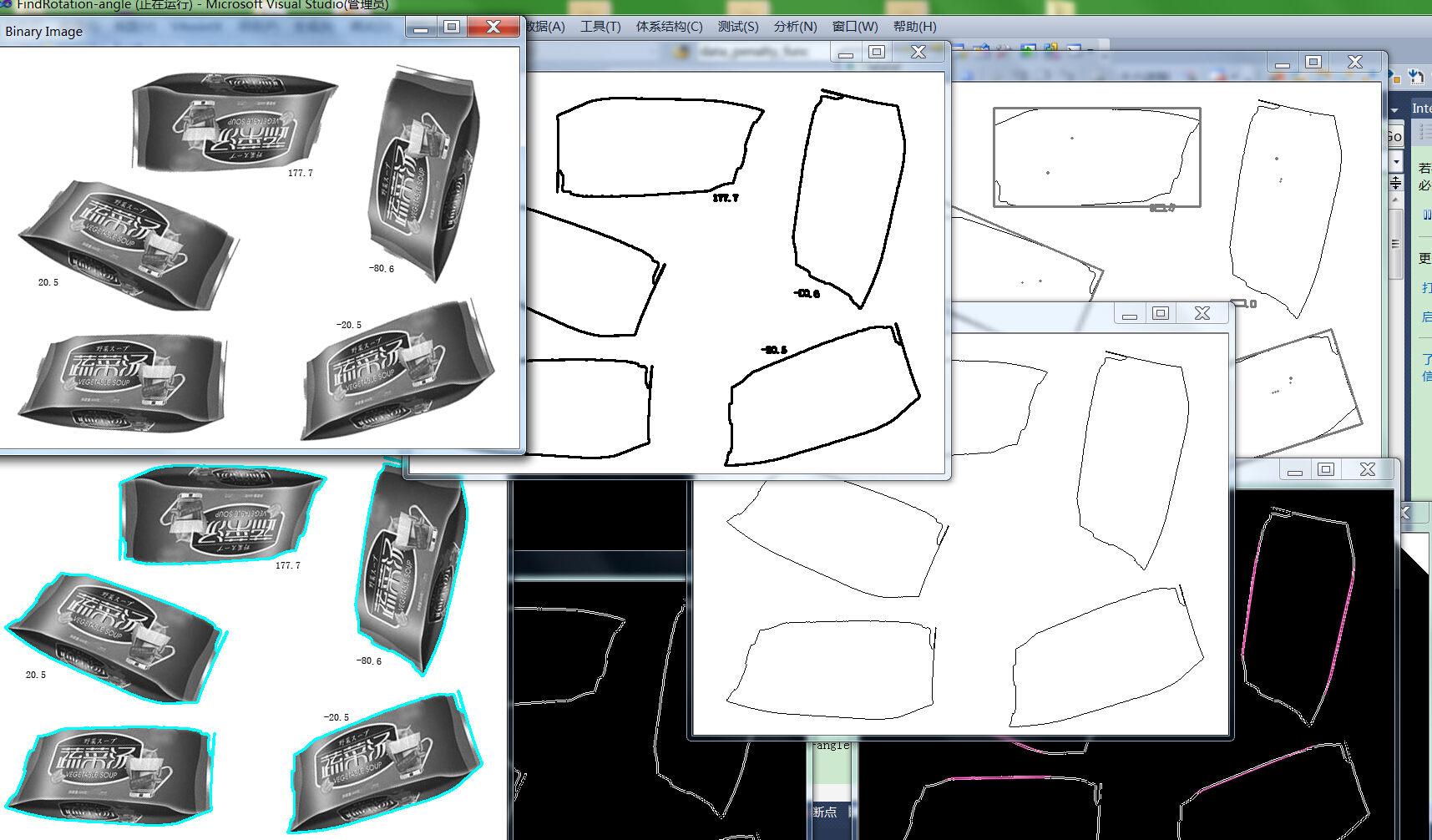效果还是有点问题的,希望大家共同探讨一下
// FindRotation-angle.cpp : 定义控制台应用程序的入口点。
//
// findContours.cpp : 定义控制台应用程序的入口点。
//
#include "stdafx.h"
#include <iostream>
#include <vector>
#include <opencv2/opencv.hpp>
#include <opencv2/core/core.hpp>
#include <opencv2/imgproc/imgproc.hpp>
#include <opencv2/highgui/highgui.hpp>
#pragma comment(lib,"opencv_core2410d.lib")
#pragma comment(lib,"opencv_highgui2410d.lib")
#pragma comment(lib,"opencv_imgproc2410d.lib")
#define PI 3.1415926
using namespace std;
using namespace cv;
int hough_line(Mat src)
{
//【1】载入原始图和Mat变量定义
Mat srcImage = src;//imread("1.jpg"); //工程目录下应该有一张名为1.jpg的素材图
Mat midImage,dstImage;//临时变量和目标图的定义
//【2】进行边缘检测和转化为灰度图
Canny(srcImage, midImage, 50, 200, 3);//进行一此canny边缘检测
cvtColor(midImage,dstImage, CV_GRAY2BGR);//转化边缘检测后的图为灰度图
//【3】进行霍夫线变换
vector<Vec4i> lines;//定义一个矢量结构lines用于存放得到的线段矢量集合
HoughLinesP(midImage, lines, 1, CV_PI/180, 80, 50, 10 );
//【4】依次在图中绘制出每条线段
for( size_t i = 0; i < lines.size(); i++ )
{
Vec4i l = lines[i];
line( dstImage, Point(l[0], l[1]), Point(l[2], l[3]), Scalar(186,88,255), 1, CV_AA);
}
//【5】显示原始图
imshow("【原始图】", srcImage);
//【6】边缘检测后的图
imshow("【边缘检测后的图】", midImage);
//【7】显示效果图
imshow("【效果图】", dstImage);
//waitKey(0);
return 0;
}
int main()
{
// Read input binary image
char *image_name = "test.jpg";
cv::Mat image = cv::imread(image_name,0);
if (!image.data)
return 0;
cv::namedWindow("Binary Image");
cv::imshow("Binary Image",image);
// 从文件中加载原图
IplImage *pSrcImage = cvLoadImage(image_name, CV_LOAD_IMAGE_UNCHANGED);
// 转为2值图
cvThreshold(pSrcImage,pSrcImage,200,255,cv::THRESH_BINARY_INV);
image = cv::Mat(pSrcImage,true);
cv::imwrite("binary.jpg",image);
// Get the contours of the connected components
std::vector<std::vector<cv::Point>> contours;
cv::findContours(image,
contours, // a vector of contours
CV_RETR_EXTERNAL, // retrieve the external contours
CV_CHAIN_APPROX_NONE); // retrieve all pixels of each contours
// Print contours' length
std::cout << "Contours: " << contours.size() << std::endl;
std::vector<std::vector<cv::Point>>::const_iterator itContours= contours.begin();
for ( ; itContours!=contours.end(); ++itContours)
{
std::cout << "Size: " << itContours->size() << std::endl;
}
// draw black contours on white image
cv::Mat result(image.size(),CV_8U,cv::Scalar(255));
cv::drawContours(result,contours,
-1, // draw all contours
cv::Scalar(0), // in black
2); // with a thickness of 2
cv::namedWindow("Contours");
cv::imshow("Contours",result);
// Eliminate too short or too long contours
int cmin= 100; // minimum contour length
int cmax= 1000; // maximum contour length
std::vector<std::vector<cv::Point>>::const_iterator itc= contours.begin();
while (itc!=contours.end()) {
if (itc->size() < cmin || itc->size() > cmax)
itc= contours.erase(itc);
else
++itc;
}
// draw contours on the original image
cv::Mat original= cv::imread(image_name);
cv::drawContours(original,contours,
-1, // draw all contours
cv::Scalar(255,255,0), // in white
2); // with a thickness of 2
cv::namedWindow("Contours on original");
cv::imshow("Contours on original",original);
// Let's now draw black contours on white image
result.setTo(cv::Scalar(255));
cv::drawContours(result,contours,
-1, // draw all contours
cv::Scalar(0), // in black
1); // with a thickness of 1
image= cv::imread("binary.jpg",0);
//imshow("lll",result);
//waitKey(0);
// testing the bounding box
//
//霍夫变换进行直线检测,此处使用的是probabilistic Hough transform(cv::HoughLinesP)而不是standard Hough transform(cv::HoughLines)
cv::Mat result_line(image.size(),CV_8U,cv::Scalar(255));
result_line = result.clone();
hough_line(result_line);
//Mat tempimage;
//【2】进行边缘检测和转化为灰度图
//Canny(result_line, tempimage, 50, 200, 3);//进行一此canny边缘检测
//imshow("canny",tempimage);
//waitKey(0);
//cvtColor(tempimage,result_line, CV_GRAY2BGR);//转化边缘检测后的图为灰度图
vector<Vec4i> lines;
cv::HoughLinesP(result_line,lines,1,CV_PI/180,80,50,10);
for(int i = 0; i < lines.size(); i++)
{
line(result_line,cv::Point(lines[i][0],lines[i][1]),cv::Point(lines[i][2],lines[i][3]),Scalar(0,0,0),2,8,0);
}
cv::namedWindow("line");
cv::imshow("line",result_line);
//waitKey(0);
/
//
//std::vector<std::vector<cv::Point>>::const_iterator itc_rec= contours.begin();
//while (itc_rec!=contours.end())
//{
// cv::Rect r0= cv::boundingRect(cv::Mat(*(itc_rec)));
// cv::rectangle(result,r0,cv::Scalar(0),2);
// ++itc_rec;
//}
//cv::namedWindow("Some Shape descriptors");
//cv::imshow("Some Shape descriptors",result);
CvBox2D End_Rage2D;
CvPoint2D32f rectpoint[4];
CvMemStorage *storage = cvCreateMemStorage(0); //开辟内存空间
CvSeq* contour = NULL; //CvSeq类型 存放检测到的图像轮廓边缘所有的像素值,坐标值特征的结构体以链表形式
cvFindContours( pSrcImage, storage, &contour, sizeof(CvContour),CV_RETR_CCOMP, CV_CHAIN_APPROX_NONE);//这函数可选参数还有不少
for(; contour; contour = contour->h_next) //如果contour不为空,表示找到一个以上轮廓,这样写法只显示一个轮廓
//如改为for(; contour; contour = contour->h_next) 就可以同时显示多个轮廓
{
End_Rage2D = cvMinAreaRect2(contour);
//代入cvMinAreaRect2这个函数得到最小包围矩形 这里已得出被测物体的角度,宽度,高度,和中点坐标点存放在CvBox2D类型的结构体中,
//主要工作基本结束。
for(int i = 0;i< 4;i++)
{
//CvArr* s=(CvArr*)&result;
//cvLine(s,cvPointFrom32f(rectpoint[i]),cvPointFrom32f(rectpoint[(i+1)%4]),CV_G(0,0,255),2);
line(result,cvPointFrom32f(rectpoint[i]),cvPointFrom32f(rectpoint[(i+1)%4]),Scalar(125),2);
}
cvBoxPoints(End_Rage2D,rectpoint);
std::cout <<" angle:\n"<<(float)End_Rage2D.angle << std::endl; //被测物体旋转角度
}
cv::imshow("lalalal",result);
cv::waitKey();
return 0;
}
这个是原来实现的代码的博客文章:
http://blog.csdn.net/wangyaninglm/article/details/41864251
参考文献:
http://blog.csdn.net/z397164725/article/details/7248096


























 9046
9046

 被折叠的 条评论
为什么被折叠?
被折叠的 条评论
为什么被折叠?








